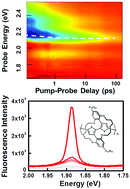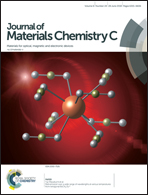Amplified spontaneous emission in insulated polythiophenes†
Abstract
Insulated polythiophenes bearing conjugated backbones, which are fully (IPT) or half (½IPT) encapsulated by cyclic side chains (IPTs), are introduced and comprehensively investigated to determine the relationship between their structure, photophysics and light-amplifying properties in the solid state. Upon full polythiophene encapsulation, we observe enhanced planarization of the conjugated backbone, which is demonstrated by the highly vibronic and mirror-image absorption and photoluminescence spectra in solution and solid state. In sharp contrast with poly(3-hexylthiophene) (P3HT), ½IPT and IPT exhibit a progressive reduction in torsional relaxation in solution together with significantly larger photoluminescence quantum efficiencies. The transient absorption (TA) spectra of ½IPT and IPT in the solid state depict clear stimulated emission (SE) bands free of spectral overlap with photoinduced absorption (PA) from inter-chain charge pairs. Furthermore, effective solid state backbone encapsulation is reflected in high SE cross-sections and efficient amplified spontaneous emission in 1/2IPT and IPT. Our results show that backbone self-sheathing enables the exploitation of single chain properties in the solid state, which is of particular relevance for lighting applications.



 Please wait while we load your content...
Please wait while we load your content...